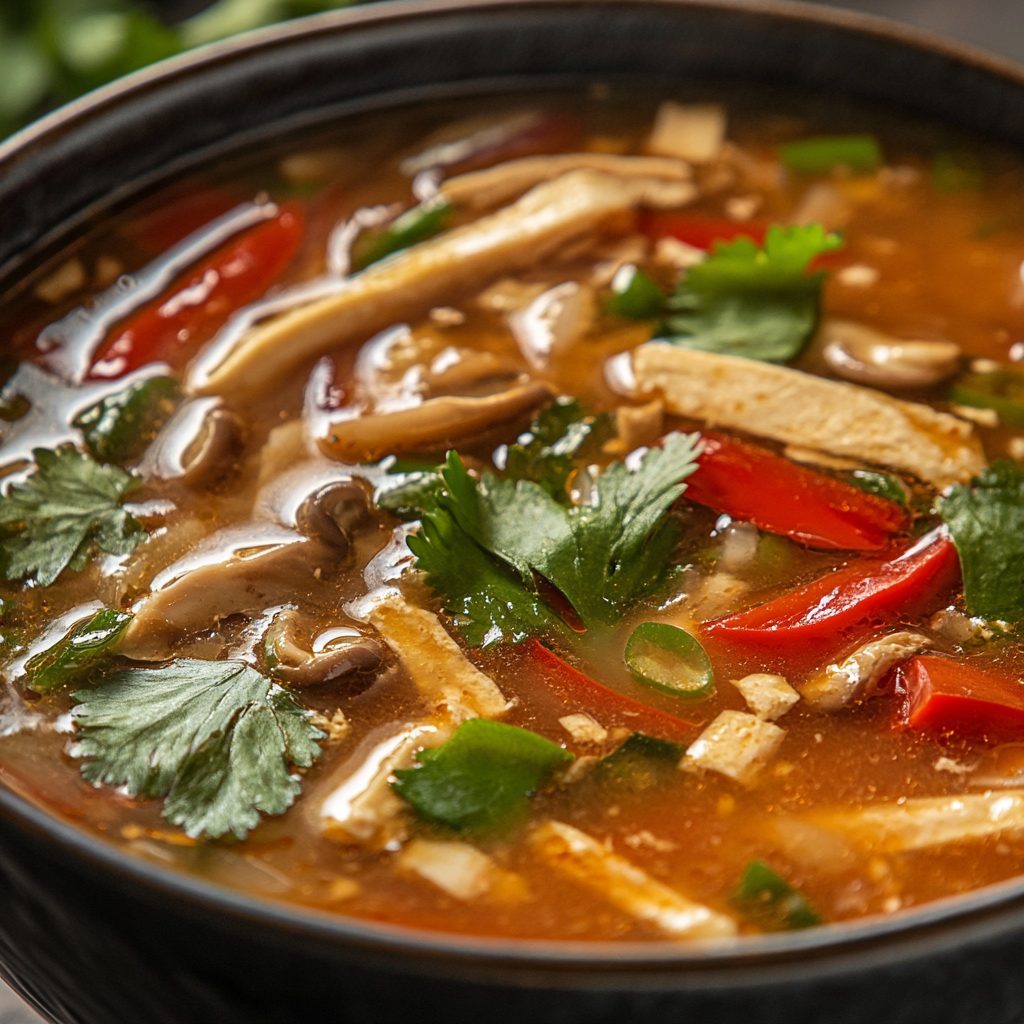Hot and Sour Soup Recipe
Hot and sour soup is a classic dish that perfectly balances the zing of spicy and the tang of sour. This beloved soup is not only flavorful but also hearty, making it an ideal comfort dish for cool evenings or a starter that wakes up the palate. Originating from various regions in Asia, it’s most associated with Chinese cuisine but is popular in many countries with variations to suit local tastes. Below, you’ll find a step-by-step guide to creating an authentic and delectable hot and sour soup.
Ingredients
Main Ingredients
- Mushrooms (shiitake or wood ear) – 1 cup, thinly sliced
- Firm tofu – 1 cup, cut into small cubes
- Chicken breast or pork loin (optional) – 1 cup, thinly sliced
- Egg – 1, beaten
- Vegetable oil – 2 tablespoons
- Ginger – 1 tablespoon, finely grated
- Garlic – 2 cloves, minced
Soup Base
- Chicken or vegetable stock – 4 cups
- Soy sauce – 3 tablespoons
- Rice vinegar – 2 tablespoons
- Chili paste or sambal oelek – 1 tablespoon (adjust for heat preference)
- White pepper – 1 teaspoon
- Salt – to taste
Thickening Agent
- Cornstarch – 2 tablespoons
- Water – 2 tablespoons (for mixing with cornstarch)
Garnish
- Green onions – 2, chopped
- Sesame oil – 1 teaspoon
- Fresh cilantro – optional, for a touch of herbaceous flavor

Step-by-Step Instructions
Step 1: Prepare the Ingredients
- Soak dried mushrooms (if using) in warm water for 20 minutes. Drain and slice thinly.
- Cut tofu and meat (if using) into uniform pieces for even cooking.
- Mince the garlic, grate the ginger, and prepare the green onions for garnish.
Step 2: Sauté Aromatics
- In a large pot, heat 2 tablespoons of vegetable oil over medium heat.
- Add garlic and ginger and sauté for 1 minute or until fragrant, being careful not to burn them.
Step 3: Build the Soup Base
- Pour in the chicken or vegetable stock.
- Add soy sauce, rice vinegar, chili paste, and white pepper. Bring the mixture to a simmer.
Step 4: Cook the Main Ingredients
- Add sliced mushrooms, tofu, and chicken/pork (if using) to the pot. Let the soup simmer for 5-7 minutes or until the protein is cooked through and the mushrooms are tender.
Step 5: Thicken the Soup
- In a small bowl, mix 2 tablespoons of cornstarch with 2 tablespoons of water to create a slurry.
- Gradually pour the slurry into the simmering soup while stirring continuously to avoid lumps. Cook for an additional 2-3 minutes until the soup thickens.
Step 6: Create the Signature Egg Ribbons
- Slowly drizzle the beaten egg into the soup while stirring gently to create delicate egg ribbons. Let it cook for about 1 minute.
Step 7: Finish with Garnishes
- Stir in the sesame oil for a burst of flavor.
- Serve the soup hot, garnished with green onions and optional fresh cilantro.

Serving and Storage Tips
- Serving: This soup is best served hot as a starter or a main course alongside dishes like fried rice or spring rolls.
- Storage: Store any leftovers in an airtight container in the refrigerator for up to 3 days. Reheat gently on the stove or in the microwave, stirring occasionally.
- Freezing: You can freeze the soup for up to a month. For best results, freeze without the egg ribbons and add them when reheating.
Helpful Notes
- Adjust Spice Level: Increase or decrease the amount of chili paste depending on your heat tolerance.
- Vinegar Variations: For a different tang, try black vinegar or white wine vinegar if rice vinegar is unavailable.
- Vegetarian Option: Use vegetable stock and skip the meat for a fully vegetarian version.
Tips from Well-Known Chefs
- Chef Ken Hom: “For a more intense mushroom flavor, add a small amount of rehydrated dried shiitake mushroom soaking water to the stock.”
- Chef Ching-He Huang: “To deepen the savory notes, a touch of hoisin sauce can add a hint of sweetness that balances the soup.”
Frequently Asked Questions
1. Can I use different types of mushrooms? Yes, you can use a mix of shiitake, button, or enoki mushrooms for varied texture and flavor.
2. How do I make the soup more sour? Add an extra tablespoon of rice vinegar or a splash of lime juice to heighten the tang.
3. What can I use instead of cornstarch? Arrowroot powder or tapioca starch can be substituted in the same ratio for thickening.
4. Is it possible to make this gluten-free? Use tamari or gluten-free soy sauce, and ensure any other additives are certified gluten-free.
5. How do I prevent the egg from clumping? Drizzle the egg slowly in a thin stream while gently stirring the soup to create delicate ribbons.
6. Can I add vegetables to this soup? Yes, thinly sliced bamboo shoots, water chestnuts, or baby corn make great additions.
7. What type of tofu works best? Firm or extra-firm tofu holds up well in the soup, while silken tofu can add a softer texture.
8. Can I skip the sesame oil? Yes, but it provides a rich, nutty flavor that elevates the dish.
9. Why is white pepper used instead of black? White pepper has a milder, more aromatic spice that blends seamlessly with the soup’s flavors.
10. What’s the best way to reheat the soup? Reheat over low to medium heat, stirring occasionally to maintain texture and avoid overcooking.
Enjoy making this hot and sour soup with its balanced flavors and hearty elements—a dish perfect for warming both body and soul.
